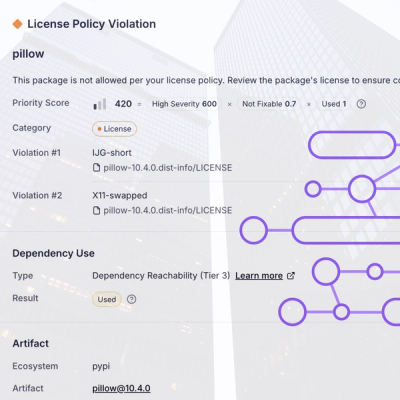
Security News
TC39 Advances 11 Proposals for Math Precision, Binary APIs, and More
TC39 advances 11 JavaScript proposals, with two moving to Stage 4, bringing better math, binary APIs, and more features one step closer to the ECMAScript spec.

An HTTP mocking server based on Nock.
Hock is an HTTP mocking server with an API designed to closely match that of Nock. The key difference between Nock and Hock is that nock works by overriding http.clientRequest, allowing requests to be intercepted before they go over the wire.
Hock is designed as a fully functioning HTTP service. You enqueue requests and responses in a similar fashion to Nock:
var http = require('http'),
hock = require('hock'),
request = require('request');
var mock = hock.createHock();
mock
.get('/some/url')
.reply(200, 'Hello!');
var server = http.createServer(mock.handler);
server.listen(1337, function () {
request('http://localhost:' + 1337 + '/some/url', function(err, res, body) {
console.log(body);
});
});
Hock supports the 5 primary HTTP methods at this time:
// Returns a hock Request object
var req = hockServer.get(url, requestHeaders);
// Returns a hock Request object
var req = hockServer.delete(url, requestHeaders);
// Returns a hock Request object
var req = hockServer.post(url, body, requestHeaders);
// Returns a hock Request object
var req = hockServer.put(url, body, requestHeaders);
// Returns a hock Request object
var req = hockServer.head(url, requestHeaders);
All of these methods return an instance of a Request, a hock object which contains all of the state for a mocked request. To define the response and enqueue into the hockServer, call either reply or replyWithFile on the Request object:
// returns the current hockServer instance
req.reply(statusCode, body, responseHeaders);
// returns the current hockServer instance
req.replyWithFile(statusCode, filePath, responseHeaders);
You can optionally send a ReadableStream with reply, for example testing with large responses without having to use a file on disk:
// returns the current hockServer instance
req.reply(statusCode, new RandomStream(10000), responseHeaders);
You can also provide functions instead of concrete values. These functions will be called with the matching incoming http request, and it useful in cases where the response body or headers need to be constructed based on the incoming request data:
// returns the current hockServer instance
req.reply(
statusCode,
function replyWithBody(request) {
return body;
},
function replyWithHeaders(request) {
return responseHeaders;
}
);
You can optionally tell hock to match multiple requests for the same route:
hockServer.put('/path/one', {
foo: 1,
bar: {
baz: true
biz: 'asdf1234'
}
})
.min(4)
.max(10)
.reply(202, {
status: 'OK'
})
Call many if you need to handle at least one, possibly
many requests:
hockServer.put('/path/one', {
foo: 1,
bar: {
baz: true
biz: 'asdf1234'
}
})
.many() // min 1, max Unlimited
.reply(202, {
status: 'OK'
})
Provide custom min and max options to many:
hockServer.put('/path/one', {
foo: 1,
bar: {
baz: true
biz: 'asdf1234'
}
})
.many({
min: 4,
max: 10
})
.reply(202, {
status: 'OK'
})
Set infinite number of requests with max(Infinity):
hockServer.put('/path/one', {
foo: 1,
bar: {
baz: true
biz: 'asdf1234'
}
})
.max(Infinity)
.reply(202, {
status: 'OK'
})
If you don't care how many or how few requests are served, you can use any:
hockServer.put('/path/one', {
foo: 1,
bar: {
baz: true
biz: 'asdf1234'
}
})
.any() // equivalent to min(0), max(Infinity)
.reply(202, {
status: 'OK'
})
hockServer.done() will verify the number of requests fits within the
minimum and maximum constraints specified by min, max, many or any:
hockServer.get('/').min(2)
request.get('/', function() {
hockServer.done(function(err) {
console.error(err) // error, only made one request
})
})
If the number of requests doesn't verify and you don't supply a callback
to hockServer.done() it will throw!
As the reply and replyWithFile methods return the current hockServer, you can chain them together:
hockServer.put('/path/one', {
foo: 1,
bar: {
baz: true
biz: 'asdf1234'
}
})
.reply(202, {
status: 'OK'
})
.get('/my/file/should/be/here')
.replyWithFile(200, __dirname + '/foo.jpg');
When a request comes in, hock iterates through the queue in a First-in-first-out approach, so long as the request matches. The criteria for matching is based on the method and the url, and additionally the request body if the request is a PUT, PATCH, or POST. If you specify request headers, they will also be matched against before sending the response.
You can filter paths using regex or a custom function, this is useful for things like timestamps that get appended to urls from clients.
hockServer
.filteringPathRegEx(/timestamp=[^&]*/g, 'timestamp=123')
.get('/url?timestamp=123')
.reply(200, 'Hi!');
hockServer
.filteringPath(function (p) {
return '/url?timestamp=XXX';
})
.get('/url?timestamp=XXX')
.reply(200, 'Hi!');
FAQs
A mocking server for HTTP requests
The npm package hock receives a total of 19,074 weekly downloads. As such, hock popularity was classified as popular.
We found that hock demonstrated a not healthy version release cadence and project activity because the last version was released a year ago. It has 2 open source maintainers collaborating on the project.
Did you know?

Socket for GitHub automatically highlights issues in each pull request and monitors the health of all your open source dependencies. Discover the contents of your packages and block harmful activity before you install or update your dependencies.

Security News
TC39 advances 11 JavaScript proposals, with two moving to Stage 4, bringing better math, binary APIs, and more features one step closer to the ECMAScript spec.

Research
/Security News
A flawed sandbox in @nestjs/devtools-integration lets attackers run code on your machine via CSRF, leading to full Remote Code Execution (RCE).

Product
Customize license detection with Socket’s new license overlays: gain control, reduce noise, and handle edge cases with precision.